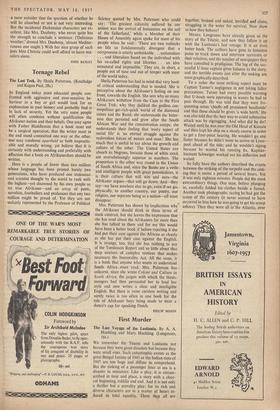First Murder
We remember the Titanic and Lusitania not because they were great disasters but because they were small ones. Such catastrophic events as the great Bengal famine of 1943 or the Indian riots of 1947 are too huge and diffuse to comprehend. But the sinking of a passenger liner at sea is a disaster in miniature. Like a play, it is circum- scribed in time and place, a story with a clear- cut beginning, middle and end. And it is not only a thriller but a morality play; for its rich and diverse characters are in a matter of hours re- duced to total equality. There they all arc together, bruised and naked, terrified and alone, struggling in the water for survival. Now show us how they behave!
Messrs. Longmans have already given us the story of the Titanic, and now they follow it up with the Lusitania's last voyage. It is an even better book. The authors have gone to immense pains to track down and interview survivors or their relatives, and the number of newspapers they have consulted is prodigious. The log of the suc- cessful U-boat captain gives balance to the story, and the terrible events just after the sinking are most graphically described.
To a sailor the most striking aspect must be Captain Turner's negligence in not taking fuller precautions. Turner had every possible warning that U-boats were operating in waters he had to pass through. He was told that they were fre- quenting areas 'chiefly off prominent headlands' and that these should be given 'a wide berth.' He was also told that the best way to avoid submarine attack was by zigzagging. And what did he do? Waited until he, was near the Old Head of Kinsale and then kept his ship on a steady course in order to get a four-point bearing. He wouldn't go any faster because he didn't want to arrive at Liver- pool ahead of the tide; and he wouldn't zigzag because he wanted his running fix, Kapitiin- leutnant Schweiger worked out his deflection and waited.
So fully have the authors described the events between the striking of the torpedo and the sink- ing that it seems a period of several hours. Yet it was only eighteen minutes. People did the most extraordinary things. One man, before plunging in, carefully folded his clothes beside a funnel. Another took photographs, saying he had got the scoop of the century (it never seemed to have occurred to him how he was going to get his scoop ashore). Then they were all in the Atlantic, over a thousand of them, the quick and the dying together. One woman kept herself afloat by hold- ing on to a corpse; another began giving birth to her baby; a third was sucked down into a funnel and then with the discharge of air shot out,•as if from a gun, to the surface. What appalled most people was the number of children's bodies, some 90 out of a total of 129, looking like 'drowned dolls.' Many of the women—as so often is the way —were tireless in helping others. But there was also the reverse of the coin. A petty officer in charge of a half-empty boat refused to pick up more survivors, and a little group of men fought each other for a place on a small keg.
We remember the Lusitania for the swiftness and intensity of her tragedy—and also because in the last analysis it defined the part that America was to play in the war. But we should remember it for another reason. It was the first time in modern warfare that the murder of civilians was accepted for military ends. It was the start of the road that led to Rotterdam, Coventry, Hamburg and Hiroshima, and which still goes on before us, out into the darkness ahead.
LUDOVIC KENNEDY



































 Previous page
Previous page